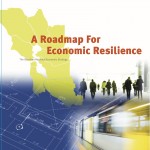The Bay Area benefits from many assets that attract global companies, investment and talent. But, over the last several decades, the region has fallen short in making the investments needed to sustain economic growth, maintain our global competitive edge and weather the inevitable downturns. This first-of-its-kind Regional Economic Strategy provides a cohesive, comprehensive roadmap for bolstering the Bay Area’s economic resilience. Overwhelmingly, the business and other leaders who were engaged over a 12-month process demonstrated a regional perspective in identifying the top opportunities for growing broad-based prosperity in the region and the requirements for success. There was a fundamental assumption that the Bay Area is a regional economy that requires coordinated regional solutions. Five major areas of recommendations are presented below:
1. Secure the Future through Critical Regional Infrastructure Investment
Infrastructure has important implications for a community’s vitality. The most recognizable involve the bridges, roads, and transit systems that facilitate the movement of goods and people. Public water systems and flood protection agencies often go unseen, but provide safe and reliable drinking water and keep communities safe. Other types of infrastructure include public buildings such as schools, hospitals, and administrative buildings, and the 21st century infrastructure comprised of the wires and cables that deliver communications services and electricity to homes and businesses. The quality and resilience of this infrastructure is critical to the shared prosperity and economic competitiveness of the region and the state. Recommendations include: 1.) Restructuring the financing of public infrastructure through the creation of an empowered regional planning, finance, and management entity. 2.) Developing new sources of traditional and alternative finance to augment public resources.
2. Change the Math for Housing Development in the Bay Area
High housing costs in the bay area have reached a crisis level, and regional policies need to address this issue by incentivizing sustainable growth and combating resistance to development. While the region’s strong economy in recent years has contributed to runaway housing costs, an inability for the Bay Area to increase its housing stock—especially for affordable rental units—has exacerbated a supply and demand mismatch. Recommendations include: 1.) Building sufficient housing stock to meet the demands of a growing regional population and help to fill historic deficits. 2.) Reducing the cost of new home construction across the Bay Area.
Read the policy recommendations to create more housing>>
3. The Region’s Economic Development Requires Focus and a Regional Perspective
The Bay Area’s regional governance structure consists of four pillar agencies, each with a distinct mission and authority. Transportation is handled by the Metropolitan Transportation Commission; land use by the Association of Bay Area Governments; air quality by the Bay Area Air Quality Management District (BAAQMD); and the bay front by state agency San Francisco Bay Conservation and Development Commission. Each aims to maintain a regional perspective, given the Bay Area’s interconnected transportation, housing, infrastructure, and workforce needs. However, sustaining the region’s economic competitiveness is not central to the planning efforts and decision-making of any of these regional agencies, the business community is largely uninvolved, and local leaders have no formal forum to engage in discussions on the economy and job growth at a regional level. A regional entity focused on economic growth is needed. Recommendation: Create the Bay Area Regional Economic Development Partnership.
Read the policy recommendations to form the Bay Area Regional Economic Development Partnership>>
4. Create an Adaptive Regional System for Workforce Development: Producing World-Class Skills and Expanding Opportunity
The bay area requires regional collaborative action on workforce development in order to improve programming and funding efficiencies and better span the growing skills gap. The Bay Area has one of the most dynamic labor markets in the country today. The unemployment rate in all of the region’s nine counties was below the statewide average of 6.2% in May 2015. In San Francisco, the unemployment rate was just 3.4% in the same month.41 While the conversation around the Bay Area’s workforce often focuses on technology companies in heavy competition for top technical talent, the region has a highly diverse economy, and employers across all sectors face challenges in finding workers with the skills they need. Recommendation: Establish the Bay Area Collaboration on Workforce Development, a regional public-private collaborative to better connect employers’ skills needs and workforce training programs and improve resource alignment.
Read the policy recommendations to establish the Bay Area Collaboration on Workforce Development>>
5. Drive Greater Efficiency in the Bay Area’s Transportation System
The transportation system serves multiple economically significant functions—it moves people to their places of work every day and is the network by which goods are moved through supply chains to their end users. If the system serves these functions well, it will enhance economic activity and facilitate a robust economy. When regional transportation systems struggle to seamlessly move goods and people, economic activity is hindered and productivity is lost. The Bay Area’s current transportation system is increasingly plagued by congestion and delays, creating lost time for Bay Area workers and lost dollars for the region’s businesses. Lack of investment in the region’s aging and overcrowded transportation systems is undermining the Bay Area’s future prosperity. In addition, a lack of strong linkages across transit agencies inhibits a systemic approach to addressing the region’s growing and changing transportation needs. Recommendation: Improve the efficiency of transportation systems in order to support the current economic growth cycle and prepare for the next.
Read the policy recommendations to improve the region’s transportation systems>>







